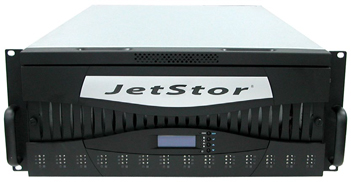Are you in need of extra space for your digital files, photos, or videos? Direct-attached storage (DAS) devices may be just the solution you need! At AC&NC we have a variety of these devices to meet your storage solutions needs.
What is Direct-Attached Storage?
Many wonder, what is DAS storage? With a DAS connection, this server-attached storage directly connects to a computer or server, with no need for a network connection. A DAS server or device provides additional space and can be used in a variety of applications, from personal computers to enterprise-level servers to store and manage large amounts of data.
Key Features of DAS
A DAS computer system or device offers several key features for customers seeking a reliable and flexible solution.
- High Performance: Connecting directly to a host system, this external storage system uses high-speed interfaces for faster data transfer and improved performance. This eliminates network latencies and allows a host system to access dedicated resources without competing with other systems or processes. With high-speed drives like SSDs or HDDs, they can be configured with RAID for fault tolerance and optimized performance, resulting in faster read/write speeds.
- Scalability: This is an important feature for most businesses looking to grow and evolve. DAS direct-attached storage is expandable, allowing for the easy addition of disks, bays, or larger drives, and even an expansion chassis. You can also upgrade the controller for better features like faster data transfer and improved fault tolerance. Scalable storage software also allows for easy expansion, making it useful for businesses or individuals who need to store large amounts of data over time.
- Data Protection: DAS data devices come with advanced data protection features that help safeguard your valuable business data. RAID provides fault tolerance and redundancy, preventing data loss in case of drive failure. Backups can be created to protect against hardware failure or disasters, and encryption can safeguard against unauthorized access. When disposing of the device, data can be securely erased, and access can be limited to authorized users.
- Easy Setup: When it comes to storage, DAS devices are easy to set up and require minimal technical expertise. The devices are easy to set up and require minimal technical expertise. Choose the enclosure that meets your requirements and interface needs. Install the drives into the enclosure, following the instructions carefully. Connect the DAS to the host system using the appropriate cable and configure it with manufacturer-provided software. Initialize and format the drives using the operating system’s disk management utility or a third-party tool. Test the setup by copying files and monitoring performance.
- Portability: A DAS hard drive is highly portable and lightweight, making it an ideal solution for on-the-go work. Smaller, more compact devices are easier to transport, and bus-powered options can be powered directly from a computer’s USB port. Rugged features like shock resistance and waterproofing protect against damage during transport. Faster transfer speeds make it easier to move large amounts of data quickly, which is important for frequent data transport.
Cost of DAS Storage
These devices are also very affordable, with several terabytes of storage available for as little as $100-$200. Larger rack-mounted servers can hold multiple terabytes of data, but these solutions can cost several thousand dollars. Regardless of the size, DAS is easy to set up and use, allowing you to start storing and accessing your data in no time.
Best Use Cases for DAS
This solution is an excellent choice for a variety of use cases. DAS devices are commonly used in video editing workflows, where high-speed storage is essential for editing large video files. By connecting a DAS device to a workstation or laptop, video editors can work with large video files in real time without experiencing performance issues.
When high-performance storage is required for large amounts of data, DAS devices are commonly used. Connecting a DAS device directly to a database server improves performance and reduces latency with higher data transfer speeds.
DAS devices can be used in virtualized environments, where high-performance storage is needed to handle the I/O operations required. By connecting a DAS device to a hypervisor host, virtual machines can be provisioned with fast and reliable storage.
As backup and archive solutions, DAS allows reliable and quick access to your data. DAS devices can be used in high-performance computing (HPC) environments, where fast and reliable storage is essential for running complex simulations and calculations. By connecting a DAS device to an HPC cluster, performance can be vastly improved.
DAS is an affordable and efficient solution. With fast data transfer rates, ease of use, and various storage capacities, DAS devices are a great choice for those who need to expand their storage capacity without breaking the bank. Before you choose, reach out to AC&NC to discuss DAS and find a solution that is a perfect fit for your business needs!

